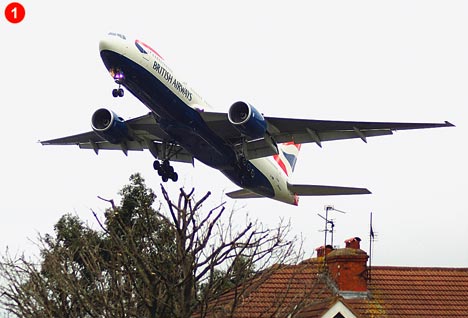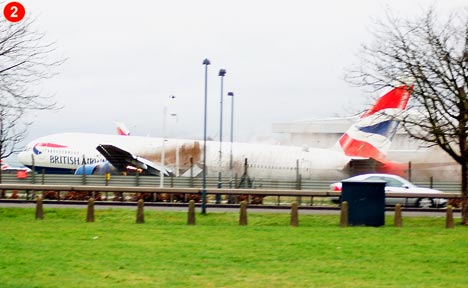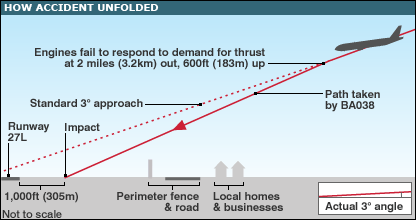« Not Enough Snow? | Main | ISBN Number for Killing Strangers »
January 20, 2008
What Caused British Airways Flight 38 (BA038) to Crash?

British Airways flight BA38 from Beijing to London crash landed short of the runway at Heathrow on Thursday January 17th. On final approach to runway 27L, the planes engines failed to generate enough thrust and the plane crash landed about 1,000 feet short of the runway. Miraculously, there were no fatalities. (Photos here)
So now, everyone's rushing to try to figure out what happened. Although everyone that posts their hypothesis seems to apologize profusely for speculating, I believe this exercise is extremely beneficial. The more people that work the problem, the quicker the problem will be solved. I'm a firm believer in the wisdom of crowds. I personally think that all information related to the crash should be posted immediately on a website for the public to digest. This includes the data from the flight data recorders and the interviews with the pilots as well.
If they have nothing to hide, then there is no reason not to release this data immediately. It can only speed up the analysis.
If it was a fuel problem, they probably wouldn't have shut off at the same time. Ditto for a fuel contamination problem. Bird strikes in both engines also seem very remote. A dual flameout of both engines at the same time is almost impossible.
I am personally leaning toward a software problem. The engines in a Boeing 777 are controlled by computers. A pilot's input on the controls is considered by the computer, but it isn't the final arbiter in every case. The computer considers all sorts of things in addition to the input from the pilot. In this case, the pilot moved to increase the thrust, but the auto-throttles failed to produce the desired thrust in the engines. It appears that both of the engines died less than a minute before the plane touched down.
Articles on the crash:
Hunt for fatal flaw of Flight 38.
'Engines running' on crash plane
Plane Passengers 'touched by God'
The mystery of flight BA038
U.K. Zeros In On Fuel System In 777 Crash
Here's the Official Initial Report.
Here's the Official Initial Report Update 23 January 2008.
Update 1: JetPhotos.net has some decent analysis of the crash.
Update 2: Discussion thread at Airliners.net.
Update 3: More from Professional Pilots Rumor Network(PPRuNe).
Update 4: In the photo above, it looks like the Boeing 777's Ram Air Turbine(RAT) was not deployed.
Update 5: In the photo above, the taxi lights are illuminated on the nose strut indicating at least one engine was at idle or greater. The landing light at the left wing root also seems to be illuminated.
Update 6: According to most airline's SOPs and BA's specifically, they must be fully stabilised by 1000' on an instrument approach. Fully stabilised is defined as being in the landing configuration, on speed, with the engines spooled up. On BA 38, the configuration was done below 1000'.
Update 7: The APU intake door was not open at the time of impact.

Update 8: There are usually a series of failures that lead to serious accidents, not a single event and it's important to not overly rely on the obvious or last event. BA038 flew for 12 hours from Bejing to London, passing over Archangel, Russia. The temperatures at altitude were among the coldest they'd ever experienced, down to as low as -70 degrees Celsius on that day.The flight crew approached the 27L runway at Heathrow on a Continuous Descent Approach(CDA). In the CDA approach, widely practiced a tHeathrow(LHR), they descend on a 3 degree glideslope with engines basically at idle from altitude down until about 1,000 feet above the ground. They do this to save gas and reduce noise as they come in over London. Then, when they tried to throttle up, the engines failed to generate thrust because the signal to the FADEC(Full Authority Digital Engine Control) engines was corrupted. The Loss of Thrust Control(LOTC) wasn't noticed until the last minute because they were basically gliding down the glideslope on autopilot with the engines idling and by the time the pilots figured out they were experiencing a loss of thrust control(LOTC), they only had approximately 40 seconds before they hit the ground. They crash landed about 1,000 feet short of the runway. It looks as though both engines were running, albeit at low power, right up until impact. The engines were operating at or about flight idle, not generating enough power to sustain flight, but enough to provide electrical, hydraulic and pneumatic power to the aircraft.

Update 9: Both engines of the British Airways jet that crash-landed at Heathrow Airport were still running when it came down, investigators have said. In its update, the AAIB said the Boeing's twin Rolls-Royce engines initially responded to the request for thrust, but after three seconds the thrust of the right engine reduced and after eight seconds there was a thrust reduction in the left one. Recorded data shows the aircraft had enough fuel and its automatic throttle and engine control systems had worked as expected, the AAIB said. The AAIB said it was now carrying out a "detailed analysis and examination of the complete fuel flow path from the aircraft tanks to the engine fuel nozzles". Source.
Update 10: The temperatures were unusually cold for the flight of BA038 and there may have been problems caused by freezing fuel (fuel waxing). The Boeing 777 has two FCOC (Fuel cooled oil coolers) in the left wing and one in the right wing. The B777 has one FCOC (Fuel Cooled Oil Cooler) heat exchanger in the left wing tank and two heat exchangers in the right wing tank. Because the left wing tank only has one heat exchanger, its fuel can be slightly colder than the right wing tank. The right engine throttled back after about 3 seconds and the left engine throttled back 8 seconds later. See Boeing's Polar Route Operations Manual - Paragraph 3 - Cold Fuel Management.
Update 11: Looks like it was ice in the fuel system that clogged the fuel lines.
Secret Pilot Decoder Ring in the Extended Entry.
Secret Pilot Decoder Ring
-------------------------
I found the IFATCA Acronym Guide and All Airline Abbreviations to be useful in decoding all of the airline jargon.
AAIB = Air Accidents Investigation Branch. (The UK equivalent of the NTSB.)
Triple - Nickname for the Boeing 777.
EEC- Electronic Engine Control, it is mounted on the engine and its the brain of the engine. Each engine has one. It is a computer that is used to do all the functions for the engine. it receives data from all the engine components and uses the data to make the engine operate at its optimum settings. It has two channels A and B. Every time the start switch is actuated the EEC channel changes. Only one channel is in control at a time. The EEC is always ready to take over in case of failure with the other channel. The other channel is monitoring the active channel to make sure they are both receiving the same data. The EEC operates on the ARINC 429 avionics data bus. The EEC is powered by the aircraft once the start switch is actuated or the EEC maintenance switch is on. Once the engine reaches a certain N1 or EPR setting then the EEC alternator powers the EEC. Meaning the engine itself is self powered by the alternator that is spinning.
FADEC-Full Authority Digital Engine Control, This is what is called when an engine is Fly By Wire. That is, no mechanical controls. The EEC controls all engine operations. The goal of FADEC is to operate the engine at its highest efficiency in all flight aspects.
AIMS- Aircraft Information Management System- On the 777 this is the brain of the aircraft. All data is brought in and through the AIMS system. There are two AIMS cabinets left and right. They are essentially the EEC of the 777 aircraft. The AIMS system makes the 777 what it is. It eliminates many avionics black boxes because the AIMS does those functions. As an example the Autothrottle computer which is found on most airliners is eliminated on the 777. The function of A/T is a function of AIMS. Other functions include, Primary Flight Displays, Flight Data Recorder System, Aicraft Conditioning System and other functions. The AIMS system receives and transmits data on four 629 buses. I could go on and on with AIMS. It is very complex and I just gave a quick description of it.
EIDU- Engine Data Interface Unit- On the 777 there are two. One each for each engine. This box is what lets the AIMS system interface with the EEC. The EECs are on the 429 bus while the AIMS is on the 629 bus. In order for the system to communicate with each other the EDIU takes care of it. It converts the data coming from the EEC to a 629 signal for AIMS to use and vice versa convert 629 to a 429 signal for the EEC to use. This is the sole way for the flight deck to make the engine do what you want it to do. You bump the throttle up and the signal is sent to the AIMS which in turn sends it to the EDIU and then to the EEC which tells the engine to add some gas. The feedback is then sent back the same way it came. The EDIUs are three channel A, B, and C.
From the engines' point of view, there is only one command...the thrust lever position. The autothrottle moves the thrust levers via servo, the flight crew does it via their arm, but the same chain happens. Thrust lever moves and updates resolver position, which commands AIMS, which commands EDIU, which commands EEC, which commands fuel/stator/etc.
The AIMS cabinets are two seperate units. They are composed of I think 8 black boxes each on two shelfs in the E/E electronic/Electrical compartment. The cabinets each have their own jobs but crosstalk with each other through four AIMS intercabinet buses. Each engine is not hooked up to the each AIMS cabinet but they are monitored by both through four channels in each cabinet. This data is provided by the two EDIU boxes. Those are for each engine.
You are correct in saying that the servos move the throttles and then the info is sent to the EEC. There are throttle servos underneath the pedestal that act just like if a pilot is moving them.
RAT - The Ram Air Turbine(RAT) is a little propeller that drops down from the side of the aircraft. The prop turns and drives an emergency hydraulic pump to operate the flight controls. In flight, the RAT automatically deploys into the airstream when both engines fail. It can also be deployed manually by a switch. Photos of a Boeing 777 RAT can be see here and here.
TAC - The Thrust Asymmetry Compensation(TAC) System continually monitors engine data to determine the thrust level from each engine. If the thrust level on one engine differs by 10 percent or more from the other engine, TAC automatically adds rudder to minimize yaw.
OAT - Outside Air Temperature.
TAT - Total Air Temperature.
MEL - Minimum Equipment List.
AD - Airworthiness Directive.
N1 - N1 is the rotational speed of the Fan in a turbine engine. Because these RPM's are high N1 is often gives as percentage of the maximum. Ex 90% of N1.
N2 - N2 is the rotational speed of the high pressure turbine. Like N1 it is also given as a % of total RPM.
N3 - Three Spoll engines also have N3, Where N1 is the fan, N2 the intermediate turbine and N3 the High pressure turbine.
FDR - Flight Data Recorder.
CVR - Cockpit Voice Recorder.
QAR - Quick Access Recorder.
FCOC - Fuel Cooled Oil Cooler
 Technorati tags: BA038 Boeing 777 British Airways plane crash FADEC EEC AIMS EIDU RAT pprune airliners.net G-YMMM LOTC FCOC N1 N2 FDR CVR QAR
Technorati tags: BA038 Boeing 777 British Airways plane crash FADEC EEC AIMS EIDU RAT pprune airliners.net G-YMMM LOTC FCOC N1 N2 FDR CVR QAR
 Delicious tags: BA038 Boeing 777 British Airways plane crash FADEC EEC AIMS EIDU RAT pprune airliners.net G-YMMM LOTC FCOC N1 N2 FDR CVR QAR
Delicious tags: BA038 Boeing 777 British Airways plane crash FADEC EEC AIMS EIDU RAT pprune airliners.net G-YMMM LOTC FCOC N1 N2 FDR CVR QAR
Folksonomy:These icons link to social bookmarking sites where readers can share web pages.























Posted by Rob Kiser on January 20, 2008 at 09:40 PM
Trackback Pings
TrackBack URL for this entry:>
http://www.peeniewallie.com/mt/mt-tb.cgi/1552
Comments
As soon as I heard the crew describe the symptoms that they experienced prior to the crash I predicted the problem would be software command of the FADEC. As time goes on, it is looking more and more like this was the cause.
Posted by: NOTR on January 21, 2008 at 10:07 PM
The interesting question is; if there is a software fault or any other slightest prospect of a fault in the aircraft in any other shape or form (than vulnerability to that described in my above posting), why is the rest of the 777 fleet in the air?
My conjecture is that the circumstances that are known to be the cause of the accident are not a threat to any other flights. Which must make something about BA038 unique and unlikely to be easily repeated. Like electromagnetic damage to the operating system from an external source.
And if this is correct but the EM emitted was say some passenger with the latest electronic gizmo where the new very high frequency generation chip manages to send out a rare frequency of sufficient strength, would the aviation authorities not react to prevent future occurrence.
If some terrorists worked-out that this would be a quick, easy cheap way to bring aircraft down and had committed this attack. Is it not a GIGANTIC coincidence that the PM was buzzing along the same road in his motorcade? They would have saved their muster and used the weapon on his aircraft.
The unique event in this matter is the PM's motorcade and my logical deduction in this respect is compounded by 777 still being allowed to be flying today.
Posted by: N11BOT on January 24, 2008 at 02:40 PM